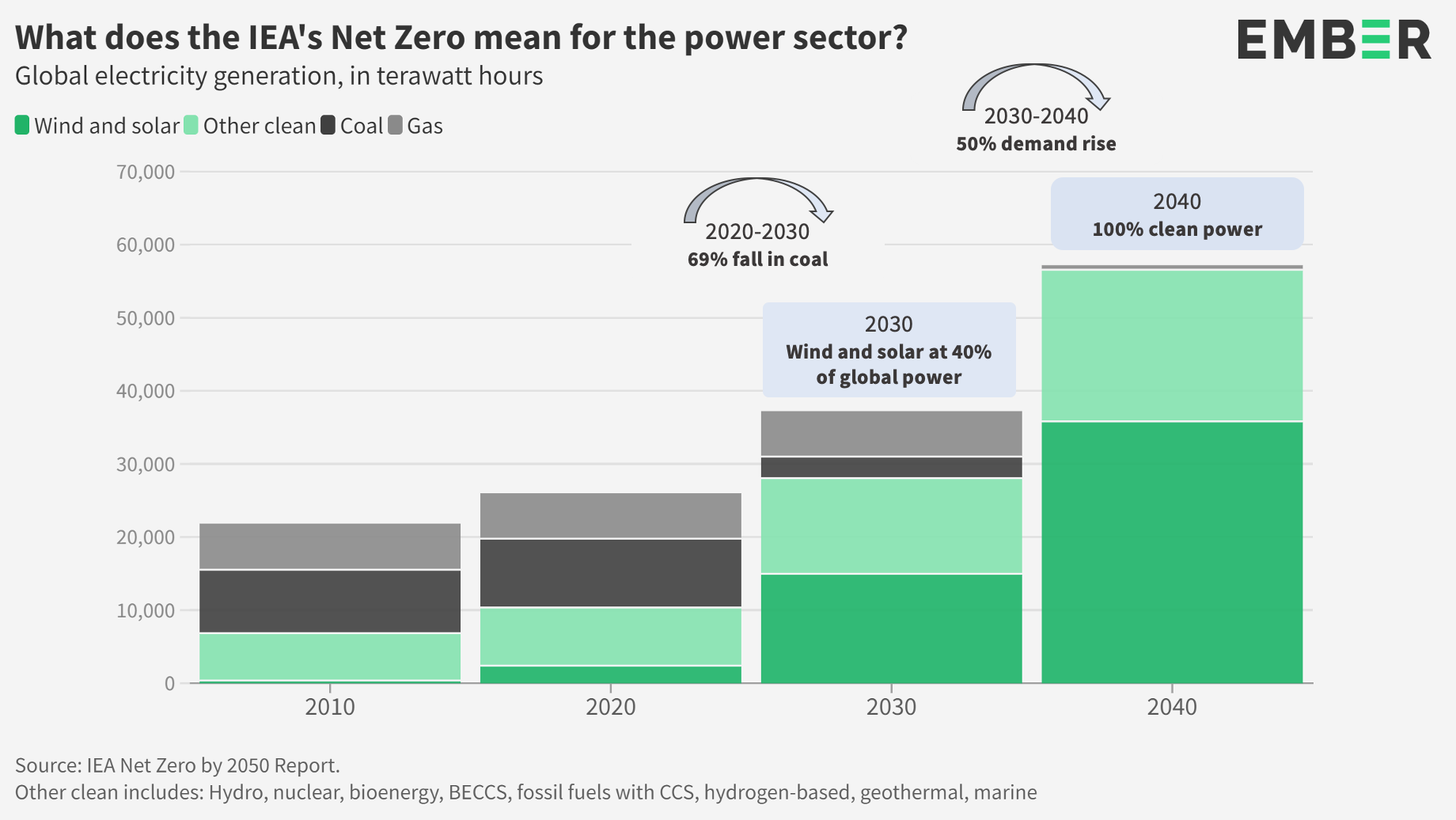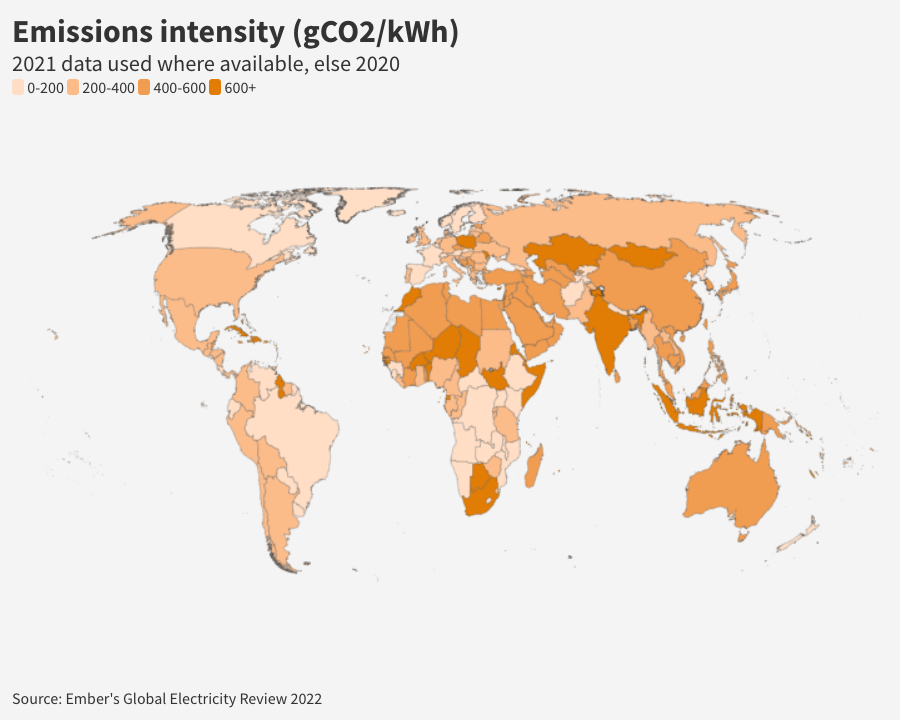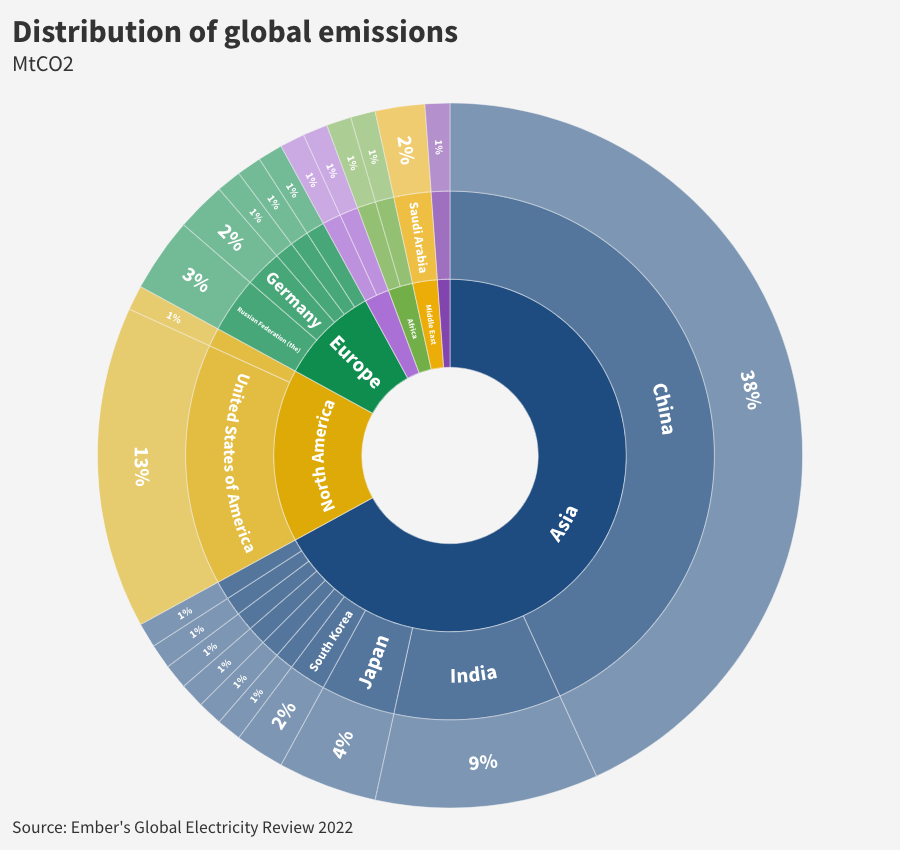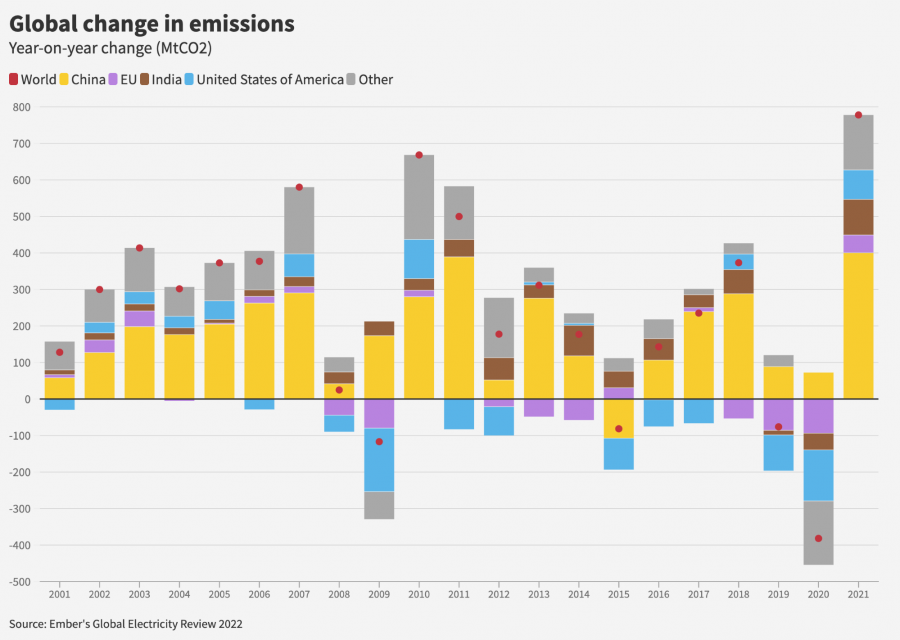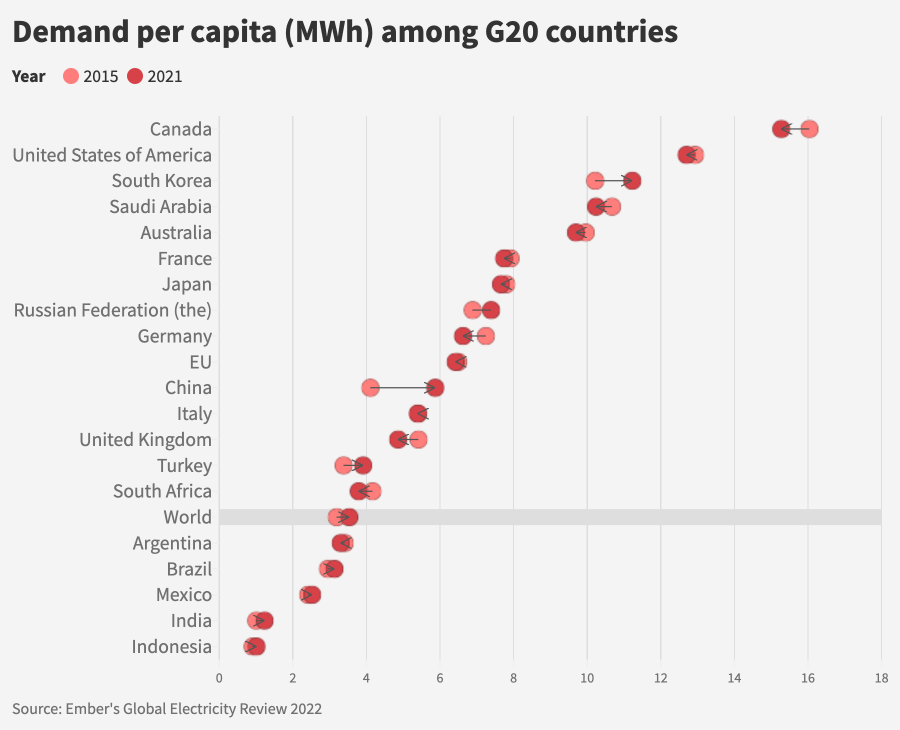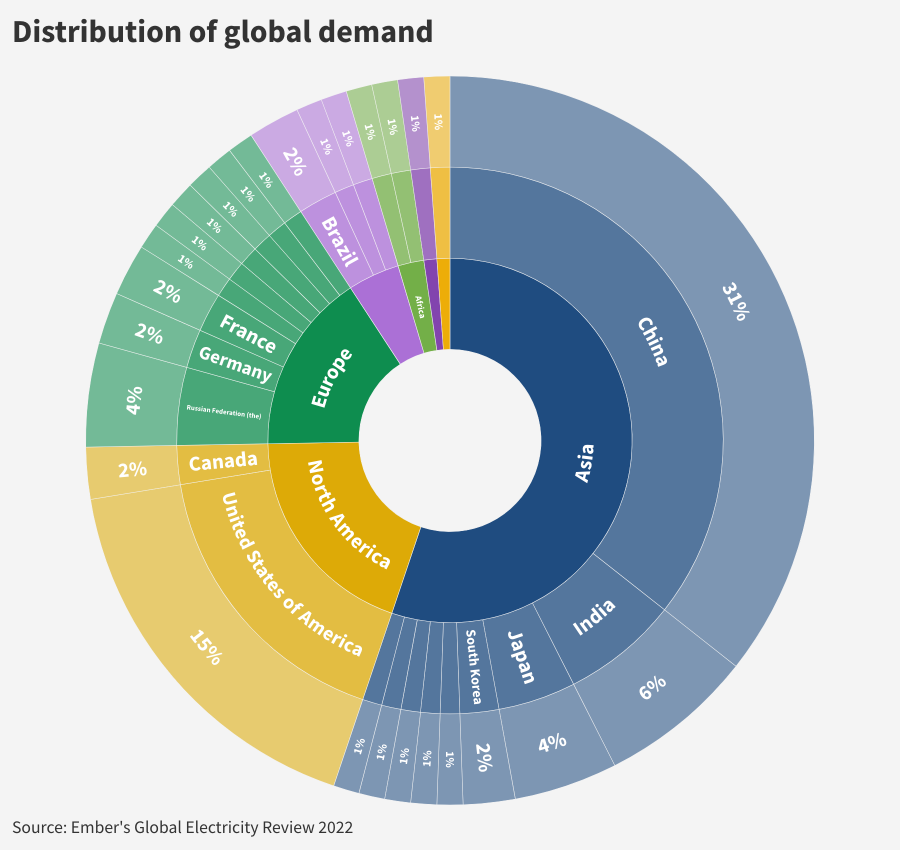
Breadcrumbs
Global Electricity Review 2022
Wind and solar, the fastest growing sources of electricity, reach a record ten percent of global electricity in 2021; all clean power is now 38% of supply. But demand growth rebounded, leading to a record rise in coal power and emissions.
Highlights
10%
Share of global electricity from wind and solar in 2021
50
Number of countries with over a tenth of electricity from wind and solar in 2021
38%
Share of global electricity from clean power in 2021
+7%
Rise in power sector CO2 emissions
+5%
Demand for electricity
29%
Share of demand growth in 2021 met by wind and solar
About
Ember’s third annual Global Electricity Review aims to provide the most transparent and up-to-date overview of changes in the global electricity transition in 2021. We make all of the data freely accessible to allow others to do their own analysis and help speed the switch to clean electricity.
We are witnessing extraordinary events in relation to our global security and global energy systems. We expect a turbulent year ahead. Even as these immediate issues must draw our attention, we know that the longer term, severe threat of climate change is only growing. We will therefore continue to monitor and report on the global impact of the electricity sector and to advocate for an effective and urgent transition to a zero emissions system, which will ultimately also help reduce our energy insecurity and exposure to geopolitical risks.
Our dataset comprises annual power generation and import data for 209 countries covering the period 2000 to 2020. For 2021, we have added data for 75 countries which together represent 93% of global power demand. You can download the data or use our Data Explorer.
This summary report—and the data behind it—is an open resource. Reliable and transparent tracking of the global electricity sector is critical to ensure effective action at the time and scale needed to keep global heating to 1.5 degrees. Alongside this analysis, we offer the comprehensive data set freely available to download or explore via our data explorer.
Ember is an independent, not-for-profit think tank. We gratefully acknowledge the philanthropic organisations that have funded us, including the European Climate Foundation, Quadrature Climate Foundation, Bloomberg Philanthropies and ClimateWorks—and thanks to everyone who has donated at the Crowd.
Executive summary
Record wind and solar - but also record coal and emissions
Wind and solar hit a tenth of global electricity, but the global electricity transition needs to sustain very high growth rates to replace coal and reduce emissions.
Dave Jones Global lead, Ember
Even as coal and power emissions hit another all-time high, there are clear signs that the global electricity transition is well underway. More wind and solar is being added to grids than ever. And not just in a few countries, but across the world. They are able—and expected—to provide the majority of clean electricity needed to phase out all fossil fuels, at the same time helping to increase energy security. But with sustained high gas prices amid Russia’s war with Ukraine, there is a real risk of relapse into coal, threatening the global 1.5 degrees climate goal. Clean electricity now needs to be built on a heroic scale. Leaders are only just waking up to the challenge of how quickly they need to move to 100% clean electricity.
Global Trends
Trends in global electricity
In this chapter:
Data
Energy Sources
Analysis of the different global electricity sources in 2021
In this chapter:
What happens to electricity demand is critical for net zero. Electricity demand rises substantially (38%) from 2020 to 2030 in the IEA’s 1.5 degree pathway, as the world economy grows, and electrification reduces fuel use in other sectors. But that’s in-part offset by a massive expected improvement in efficiency. The large rise in electricity demand in 2021 suggests the world is still not learning to use electricity as efficiently as it needs to.
Supporting Material
Downloads
- Report - GER22 - PDF (5 MB)
- CN_Report-GER22 - PDF (11 MB)
- SP_Report-GER22 - PDF (8 MB)
- Data - GER22 - XLSX (7 MB)
- Graphics Pack - GER22 - ZIP (23 MB)
- Methodology - GER22 - PDF (844 KB)
- Chinese - Executive Summary - GER22 - PDF (406 KB)
- Spanish - Executive Summary - GER22 - PDF (354 KB)
- Arabic - Executive Summary - GER22 - PDF (396 KB)
- Japanese - Executive Summary - GER22 - PDF (420 KB)
- Vietnamese - Executive Summary - GER22 - PDF (359 KB)
Methodology
Overview
This report analyses annual power generation and import data for 209 countries from 2000 to 2020, with 2021 data included for 75 countries representing 93% of global power demand. Data is collected from multi-country datasets (EIA, Eurostat, BP, UN) as well as national sources (e.g China data from the National Bureau of Statistics). The latest annual generation data is estimated using monthly generation data. Annual capacity data is collected from GEM, IRENA and WRI, and is included for as many countries as it is available for.
All the data can be viewed and downloaded freely from Ember’s website. A detailed methodology can be accessed here.
Disclaimer
The data used in this report is provided on an ‘as is’ basis. Data is assembled using the best available data at the time of publication. Every effort has been made to ensure accuracy, and where possible we compare multiple sources to confirm their agreement. We take no responsibility for errors.
If you notice an issue or have any suggestions, please do contact us at [email protected].
Fuel Definitions
Fuel data is mapped into nine generation types: Bioenergy, Coal, Gas, Hydro, Nuclear, Other Fossil, Other Renewables, Solar, and Wind. More information on mapping for different sources and countries can be viewed below.
1 Solar includes both solar thermal and solar photovoltaic generation, and where possible distributed solar generation is included.
2 Where possible, hydro generation excludes any contribution from pumped hydro generation.
3 Other renewables generation includes geothermal, tidal and wave generation.
4 Other fossil generation includes generation from oil and petroleum products, as well as manufactured gases and waste.
Caveat on bioenergy
Bioenergy has typically been assumed (by the IPCC, the IEA, and many others) to be a renewable energy source, in that forest and energy crops can be regrown and replenished, unlike fossil fuels. It is included in many governmental climate targets, including EU renewable energy legislation, and so Ember includes it in “renewable” to allow easy comparison with legislated targets.
However, the climate impact of bioenergy is highly dependent on the feedstock, how it was sourced and what would have happened had the feedstock not been burnt for energy. Current bioenergy sustainability criteria, including those of the EU, generally do not sufficiently regulate out high-risk feedstocks and therefore electricity generation from bioenergy cannot be automatically assumed to deliver similar climate benefits to other renewables sources. Given the availability of risk-free alternatives to generating electricity such as wind and solar, Ember advocates for countries to minimise or eliminate the inclusion of large-scale bioenergy in the power sector. For more information please see our reports: Understanding the Cost of the Drax BECCS Plant to UK Consumers (May 2021), The Burning Question (June 2020), and Playing with Fire (December 2019).
Methods
Compiling a full dataset from 2000 to 2021 requires using data at multiple timescales. Annual generation data is collected from both national and multi-country sources. For the most recent years, data is often not available. In these cases we use monthly data, which is reported on a shorter lag, to estimate the latest annual generation.
Power data is gathered in a wide variety of formats from multiple sources. In addition to this reconciliation, our data requires considerable cleaning and adjustment of the raw data reported. An overview of our methods is below.
Annual data
Annual data is published with a significant lag, and is generally only available until 2019 or 2020. A number of countries report generation data in 2020 for most but not all fuels. Where this occurs, missing fuels are simply carried forward from the previous year. For net imports, data for missing years is carried forward.
Monthly data
In several cases monthly data is reported on a lagged basis, or data may not be available. In these cases, incomplete months are projected based on both seasonal and interannual trends. Given the unusual nature of power generation during the COVID-19 pandemic, we use 2019 rather than 2020 as a point of reference.
Estimating latest yearly data
Monthly data does not always align with annual data: different types of generation may be included at different scales, or coverage may differ. Where conflicts occur, annual data is generally more accurate. As such, we project latest generation data by applying absolute changes by fuel from available annualised monthly data to historical annual values. In the few cases where a specific fuel is not available in monthly data, it is treated as having shown no change in the annualised projection. As such, note that simply summing up monthly values will not produce the same results as our annual values for any given year.
Thermal disaggregation
Some countries do not report disaggregated generation from fossil fuels. This was performed by Ember using two methods. If possible, the split between fossil fuels was estimated using the ratios of fossil generation in annual data, capacity data or monthly data that provides a split between fuels.
Regional and world estimates
Although our data covers the vast majority of the world’s electricity generation for 2021, data is not available for all countries. As such, regional and world figures for this year are estimated. The relative changes in included countries are applied to the latest complete datapoint for a given region and the world to arrive at the estimated value. Electricity imports and exports are not included in estimates for regional or world values.
Emissions data
We report emissions values by fuel type, and emissions intensity by country. These values are calculated by multiplying our generation numbers by emissions factors taken from the IPCC 5th Assessment Report Annex 3 (2014). These figures aim to include full lifecycle emissions including upstream methane, supply-chain and manufacturing emissions, and include all gases, converted into CO2 equivalent over a 100 year timescale.
The emissions intensities we use are below, in carbon dioxide equivalent emitted per kilowatt hour of electricity (gCO2eqkWh-1):
- Coal: 820
- Gas: 490
- Other Fossil: 700
- Wind: 11
- Solar: 48
- Bioenergy: 230
- Hydro: 24
- Other Renewables: 38 (in line with the IPCC’s “geothermal”)
- Nuclear: 12
IPCC figures still represent the most comprehensive attempt to estimate global fuel emissions intensities. Nonetheless, these emissions factors may differ from reality for a variety of reasons. Please see our complete methodology for more details.
Acknowledgements
Data: Maciej Zieliński; Jeremy Fletcher; Matt Ewen; Nicolas Fulghum; Pete Tunbridge
Analysis: Dave Jones; Aditya Lolla; Alison Candlin; Bryony Worthington; Charles Moore; Hannah Broadbent; Harry Benham; Muyi Yang; Phil MacDonald



